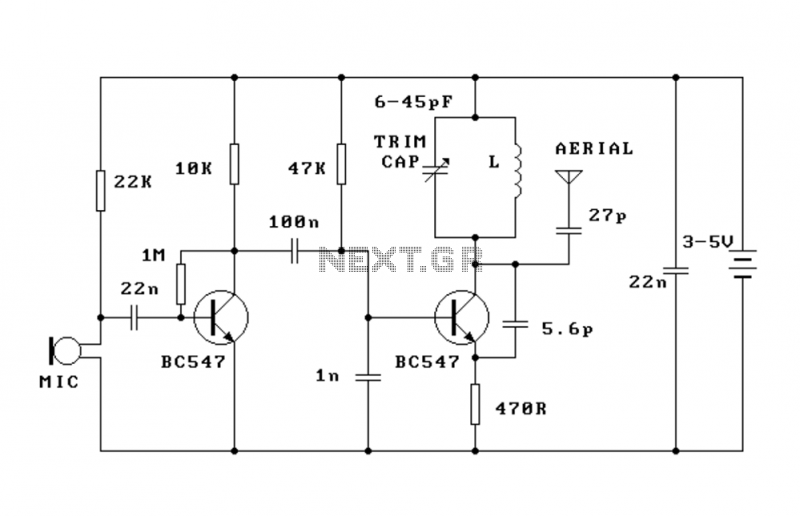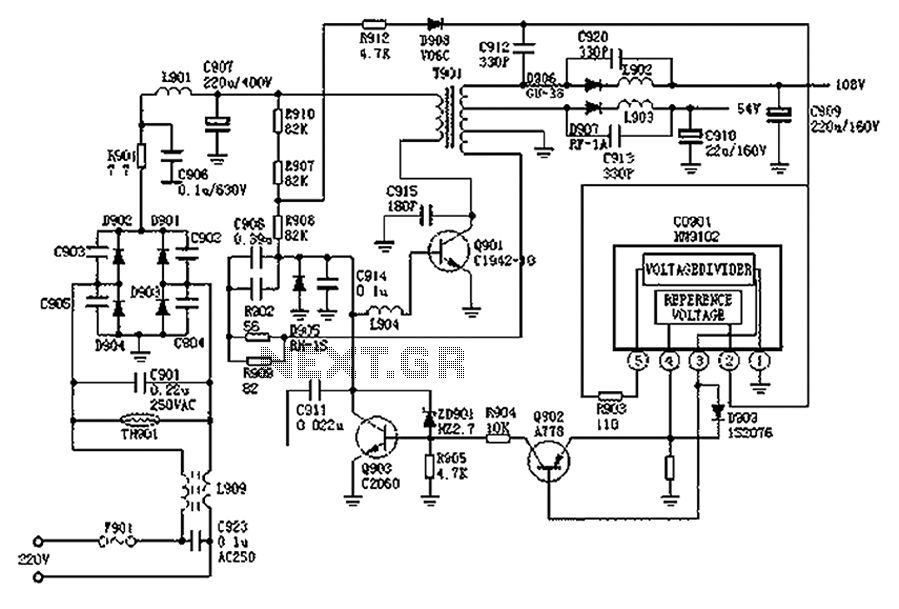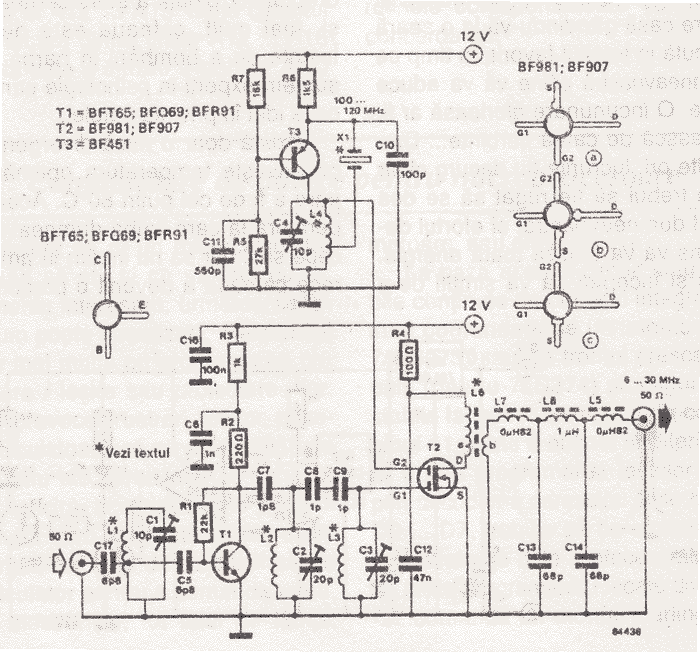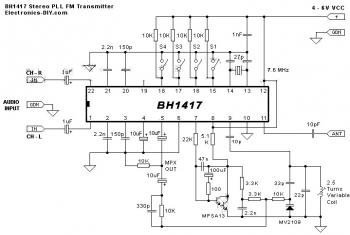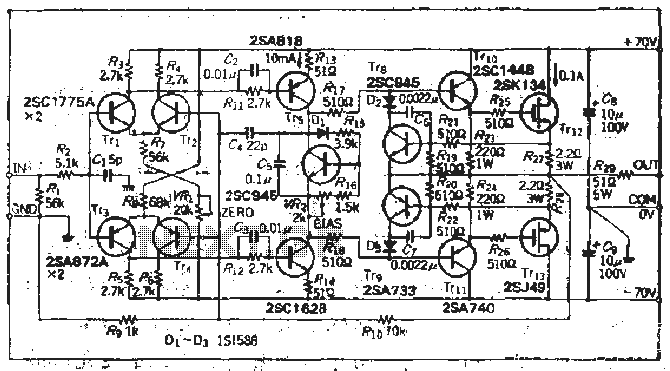
Booster Amplifier For Car Stereo Use Circuit
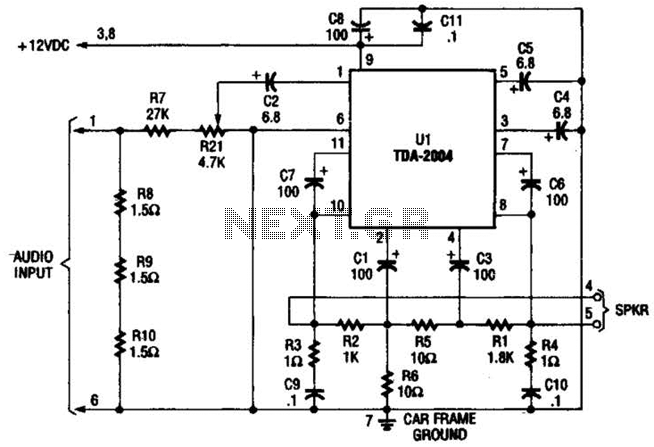
Only one channel of this circuit is shown. The other is practically identical. The input to the circuit, taken from the speaker output of a car radio, is divided into two paths. In one path, a high-power divider network (comprising resistors R8 through R10) provides a resistance of 4.5 ohms to ensure the circuit's input impedance is compatible with the output impedance of the car radio. In the other path, the signal is directed to the input of U1 through resistor R7, trimmer potentiometer R21, and capacitor C2. Together, R7 and R21 offer a minimum resistance of 27,000 ohms. The integrated circuit U1, a TDA-2004 audio power amplifier, amplifies the signal, which is then output at pins 8 and 10 and sent to the loudspeaker. Note: This amplifier is designed for use only with car radios whose speaker outputs are referenced to ground; it should not be used with radios that have balanced outputs.
This circuit is designed to enhance audio output from a car radio by utilizing a single-channel TDA-2004 audio power amplifier. The circuit architecture begins by taking the speaker output from the car radio, which is typically a low-level audio signal. This signal is then divided into two distinct paths to optimize performance and ensure compatibility with the radio's output characteristics.
The first path employs a high-power divider network consisting of resistors R8, R9, and R10. This network is critical for matching the input impedance of the amplifier circuit to the output impedance of the car radio, which is essential for maximizing power transfer and minimizing signal distortion. The specified resistance of 4.5 ohms is carefully chosen to provide a balanced load for the radio's output stage.
In the second path, the audio signal is routed through resistor R7, trimmer potentiometer R21, and capacitor C2. The potentiometer allows for fine-tuning of the signal level before it reaches the amplifier, providing flexibility in adjusting the gain. The combination of R7 and R21 provides a minimum resistance of 27,000 ohms, which is necessary for proper operation of the amplifier while ensuring that the input signal is adequately conditioned.
The TDA-2004 integrated circuit serves as the core amplification component. It is specifically designed for automotive applications, providing robust audio amplification with low distortion. The amplified output is available at pins 8 and 10 of the IC, which are connected to the loudspeaker. The design emphasizes that the amplifier is intended for use only with car radios that have speaker outputs referenced to ground, as using it with radios that have balanced outputs could lead to improper functioning or damage to the circuit.
Overall, this circuit exemplifies an effective approach to enhancing car audio systems, leveraging a combination of impedance matching, signal conditioning, and amplification to deliver improved sound performance. Only one channel of this circuit is shown. The other is practically a carbon copy.The input to the circuit, taken from your car radio`s speaker output, is divided along two paths; in one path, a high-power divider network (consisting of R8 through R10) provides 4.5- resistance to make the circuit`s input impedance compatible with the output impedance of the car radio. In the other path, the signal is fed to the input of Ul through resistor LR7, trimmer potentiometer R21, and capacitor C2.
Together, R7 and R21 offer a minimum resistance of 27,000 .Integrated circuit Ul (a TDA-2004 audio power amplifier) amplifies the signal, which is then output at pins 8 and 10 and fed to the loudspeaker. Note: This amp is designed for use only with car radios whose speaker outputs are referenced to ground: do not use it with radios that have balanced outputs. 🔗 External reference
This circuit is designed to enhance audio output from a car radio by utilizing a single-channel TDA-2004 audio power amplifier. The circuit architecture begins by taking the speaker output from the car radio, which is typically a low-level audio signal. This signal is then divided into two distinct paths to optimize performance and ensure compatibility with the radio's output characteristics.
The first path employs a high-power divider network consisting of resistors R8, R9, and R10. This network is critical for matching the input impedance of the amplifier circuit to the output impedance of the car radio, which is essential for maximizing power transfer and minimizing signal distortion. The specified resistance of 4.5 ohms is carefully chosen to provide a balanced load for the radio's output stage.
In the second path, the audio signal is routed through resistor R7, trimmer potentiometer R21, and capacitor C2. The potentiometer allows for fine-tuning of the signal level before it reaches the amplifier, providing flexibility in adjusting the gain. The combination of R7 and R21 provides a minimum resistance of 27,000 ohms, which is necessary for proper operation of the amplifier while ensuring that the input signal is adequately conditioned.
The TDA-2004 integrated circuit serves as the core amplification component. It is specifically designed for automotive applications, providing robust audio amplification with low distortion. The amplified output is available at pins 8 and 10 of the IC, which are connected to the loudspeaker. The design emphasizes that the amplifier is intended for use only with car radios that have speaker outputs referenced to ground, as using it with radios that have balanced outputs could lead to improper functioning or damage to the circuit.
Overall, this circuit exemplifies an effective approach to enhancing car audio systems, leveraging a combination of impedance matching, signal conditioning, and amplification to deliver improved sound performance. Only one channel of this circuit is shown. The other is practically a carbon copy.The input to the circuit, taken from your car radio`s speaker output, is divided along two paths; in one path, a high-power divider network (consisting of R8 through R10) provides 4.5- resistance to make the circuit`s input impedance compatible with the output impedance of the car radio. In the other path, the signal is fed to the input of Ul through resistor LR7, trimmer potentiometer R21, and capacitor C2.
Together, R7 and R21 offer a minimum resistance of 27,000 .Integrated circuit Ul (a TDA-2004 audio power amplifier) amplifies the signal, which is then output at pins 8 and 10 and fed to the loudspeaker. Note: This amp is designed for use only with car radios whose speaker outputs are referenced to ground: do not use it with radios that have balanced outputs. 🔗 External reference
Warning: include(partials/cookie-banner.php): Failed to open stream: Permission denied in /var/www/html/nextgr/view-circuit.php on line 713
Warning: include(): Failed opening 'partials/cookie-banner.php' for inclusion (include_path='.:/usr/share/php') in /var/www/html/nextgr/view-circuit.php on line 713
